Read more in:

Listen to interview with Richard Brennan about children & posture

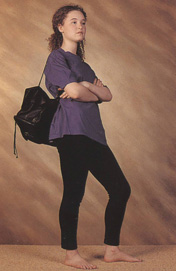

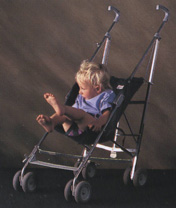

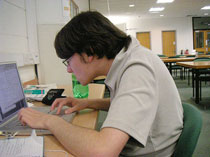
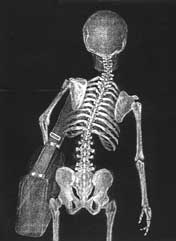
© BackCare - reproduced by kind permission
Children, Posture and Education
Please sign our petition to ban backward-sloping school chairs:
— More details on our School Chairs Campaign page
Listening to an educational programme on the radio recently, I heard a school headmaster commenting that he was very concerned with the changes that he saw in children during their school years. He saw children of five or six with bright eyes, smiling faces, beautiful posture and ease of movement; they were nearly always talkative, eager to please, willing to learn and enthusiastic about life.
 By
the time these children left the school at sixteen they hardly looked anyone in the eye,
their posture was very slumped with rounded shoulders,
they were often lazy and uncaring about the people around them and they generally looked unhappy.
'What,' he was asking, 'in the name of education are we doing to our children to make them change so dramatically?'
In my view the answer is simple: we, as a society, remove children's freedom of choice.
We do this physically by making them sit for long hours, mentally by putting them under unnecessary stress at examination time,
and emotionally by making them feel inferior or stupid when they do not conform to the status quo.
By
the time these children left the school at sixteen they hardly looked anyone in the eye,
their posture was very slumped with rounded shoulders,
they were often lazy and uncaring about the people around them and they generally looked unhappy.
'What,' he was asking, 'in the name of education are we doing to our children to make them change so dramatically?'
In my view the answer is simple: we, as a society, remove children's freedom of choice.
We do this physically by making them sit for long hours, mentally by putting them under unnecessary stress at examination time,
and emotionally by making them feel inferior or stupid when they do not conform to the status quo.
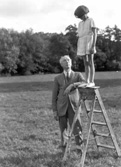 It is easy
for anyone to see that four or five year olds have beautiful posture and move with great ease and agility.
They are constantly varying their movements to suit their moods - sometimes hopping, then skipping, sometimes walking slowly and deliberately,
and the next minute running wildly. They do not have to stress their bodies by being in certain places at definite times.
Children at this age have a free spirit which is a pleasure to witness.
In contrast, by the time they leave school most of this spontaneity has disappeared, as they begin to stereotype certain movements,
reflecting the way they feel emotionally. These movements become ingrained and turn into unconscious habits,
which frequently put disproportionate strains on certain muscles, joints and internal organs to the point where the body is no longer
able to work efficiently. Is it not true that we can often recognise our adult friends merely by the way they stand or walk?
Often people think this is a normal part of getting old, but in other, 'uncivilised' societies, the adults'
posture and flexibility of movement remain unimpaired for most of their lives. In India or Africa, for example,
the average man or woman in their sixties would find squatting easy and natural, which is not the case with most people in Western cultures.
It is easy
for anyone to see that four or five year olds have beautiful posture and move with great ease and agility.
They are constantly varying their movements to suit their moods - sometimes hopping, then skipping, sometimes walking slowly and deliberately,
and the next minute running wildly. They do not have to stress their bodies by being in certain places at definite times.
Children at this age have a free spirit which is a pleasure to witness.
In contrast, by the time they leave school most of this spontaneity has disappeared, as they begin to stereotype certain movements,
reflecting the way they feel emotionally. These movements become ingrained and turn into unconscious habits,
which frequently put disproportionate strains on certain muscles, joints and internal organs to the point where the body is no longer
able to work efficiently. Is it not true that we can often recognise our adult friends merely by the way they stand or walk?
Often people think this is a normal part of getting old, but in other, 'uncivilised' societies, the adults'
posture and flexibility of movement remain unimpaired for most of their lives. In India or Africa, for example,
the average man or woman in their sixties would find squatting easy and natural, which is not the case with most people in Western cultures.
Chairs
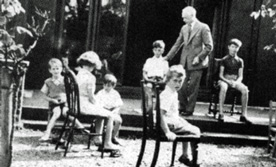 At the
age of five every child is forced to sit in a chair - she (or he) has no choice.
She does not like sitting down for more than a few moments, as the chair itself is very uncomfortable;
the main reason for this is that the horizontal part of the chair - the part that takes most of the weight of the body - is sloping backwards.
The child is then forced to tense many of her muscles to maintain the upright posture that is so natural to young children.
She does not like this feeling at all and within minutes will try to stand up or wander off.
The teacher, often having thirty and sometimes even forty children to cope with,
cannot keep his eye on this many children unless they are at their desks and,
since the teacher's main responsibility is for the safety of all these children,
he will insist that they remain on their chairs. Still not liking the sense of 'falling backwards' that the chair produces,
nearly all the children tilt forwards by raising the back legs off the floor thus producing the effect of sitting on a forward sloping chair -
this allows the child to maintain his posture effortlessly.
At the
age of five every child is forced to sit in a chair - she (or he) has no choice.
She does not like sitting down for more than a few moments, as the chair itself is very uncomfortable;
the main reason for this is that the horizontal part of the chair - the part that takes most of the weight of the body - is sloping backwards.
The child is then forced to tense many of her muscles to maintain the upright posture that is so natural to young children.
She does not like this feeling at all and within minutes will try to stand up or wander off.
The teacher, often having thirty and sometimes even forty children to cope with,
cannot keep his eye on this many children unless they are at their desks and,
since the teacher's main responsibility is for the safety of all these children,
he will insist that they remain on their chairs. Still not liking the sense of 'falling backwards' that the chair produces,
nearly all the children tilt forwards by raising the back legs off the floor thus producing the effect of sitting on a forward sloping chair -
this allows the child to maintain his posture effortlessly.
Children have a natural ingenuity and intelligence that surpasses all the superimposed learning that is placed on them. Instead of the adult asking why most children tilt their chairs forward, they will tell the child exactly what they themselves were taught, 'Don't swing on the chairs - you will break them!' There is of course the danger element that someone could trip over the back legs or that the children might tilt too far, fall forward and hurt themselves, but it is interesting that it is usually the damage to the chair that people give as a reason. The damage to the child's posture is not even considered.
The child still does not give up; she then develops the technique of tucking one leg underneath her and sitting on it, which also has the effect of raising up the pelvis, once again enabling her to keep her upright posture. This, in many cases, is actively discouraged as it can interfere with the flow of blood down the leg. The child then has to endure sitting in backward sloping chairs for literally thousands and thousands of hours. Sooner or later she begins to slump as her back muscles become more and more fatigued. To make the problem worse, the child then has to bend over her school work and since it is impossible for her to use her hip joint (as the pelvis is already tilting backwards because of the shape of the seat), she will then bend her spine, causing unnecessary wear and tear on the vertebrae and discs.
So first we ruin our children's posture and then, in our ignorance, we blame the children themselves for having poor posture. They are told to 'sit up straight and 'put your shoulders back', and the only way to do this is to arch the lumbar spine with more tension than ever. The child then begins to think that this is the way she ought to sit. Unfortunately, this posture becomes fixed within the body and can often remain with the child for the rest of her days, becoming progressively more painful as time goes on. These days the problem starts earlier than school because most childrens' pushchairs and car-seats, usually used from birth, are also sloping backwards.
Since many of us have been through this same process, it is hardly surprising that there are millions of people at this very moment with pain in the lumbar region. I am personally convinced that the posture we are told to hold as children and the phenomenal rise in neck and back pain in recent years are directly related.
Note: Using a forward-sloping wedge-shaped cushion or a well designed chair can help prevent this damage to childrens' posture.
Emotional Prison
Failure is instructive. The person who really thinks learns quite as much from his failures as from his successes.
— John Dewey
For eleven years of the child's development we place them in a institution full of 'must', 'have to', 'can't', 'should', 'got to' and 'ought to'. This has the detrimental effect of the child gradually losing his or her openness. If you imprison a bird at first it will damage itself in its endeavour to escape, every day longing for its freedom to fly unhindered, but if you keep the bird in its cage long enough it will forget that there is anything more than the cage, and then even if you leave the cage-door open it will not try to escape - it has resigned itself to life in the cage. In the same way, many children scream, shout and have tantrums during their first days of school, but we make them go, and even the most loving parents will leave their children crying at the school gate regardless of their feelings and parental instincts, because they believe it is 'for the good of the child'. This can have a detrimental effect on the child, as it may well be the first major instance in which the child feels abandoned and betrayed, not understanding that the parents themselves really feel that they have no choice, as they think it is the law of the land that every child should go to school. This is not the case, but it is what most people believe.
It is true that after a few weeks of trauma the typical child will 'settle down', but what is in fact happening is that she is becoming institutionalised as she learns how to conform to what society considers to be the norm. It is not long before many parents can see signs of a change in the child's behaviour as she becomes more and more withdrawn. By the time these children leave school many years later as young adults they have been conditioned to think in certain ways, acquiring fixed prejudices and rigid opinions which often stay with them for the rest of their lives. They feel they must act in a way that fits in with the rest of society, and that if they do not they will be ostracised by their fellow humans, due to the very same prejudices and fears that have been indoctrinated during those school years.
For many of our early years most of us are cooped up in an environment that is often confusing, humiliating and even at times hostile - especially for a five-year-old. We have to learn very quickly how to protect ourselves from the punishment given by the adults, and the ridicule and bullying from the other children. As a result, many children become more introverted and often think that there is something wrong with them, and this gives rise to many emotional problems later in life. In his book How Children Fail, teacher and educationalist John Holt writes:
For every instance of physical brutality, there are many more of mental and spiritual brutality; sarcasm, mockery, insults - what Professor of Education Arthur Pearl, who has spent much time in classrooms himself, calls 'ceremonies of humiliation'. These begin in the earliest grades, when even the poorest children are trusting, hopeful, and in many cases incapable of doing teachers any physical harm. There are enough examples to fill many books.
You will often find children of four or five very open and it is easy to have long conversations with them, but by the time they are eleven or twelve it can be difficult to get more than the odd sentence out of them. They have become afraid of saying the wrong thing.
Following along the same lines, British headmaster Michael Sullivan wrote in an article in the Times Educational Supplement (18 October 1985):
Self confidence is developed through the reduction of fear, stress, uncertainty, confusion and failure - the very tools that too many of us skilfully use in the management of children in our charge. Children are fearful of verbal abuse, physical abuse and sarcasm. Children are stressed on the rack of tests and quizzes, often facing inevitable personal humiliation.
These are very strong words from people who work and have taught in schools for many years, but we hardly need them to tell us what we already know. Many of us have endured the above traumas; some of us remember isolated incidents, but mostly we block out such memories because they are too painful to endure - yet our muscles remember them on an unconscious level.
The protection that we acquire over those all-important years of our development manifests itself in muscle tension as our shoulders become rounded or hunched, our backs become arched and we stoop more and more. These muscular tensions will subsequently affect the alignment of the rest of the body and can often sow the seeds of future ill-health. They will affect our lives on every level unless we are willing to release them from our body and this is where the Alexander Technique comes in.
